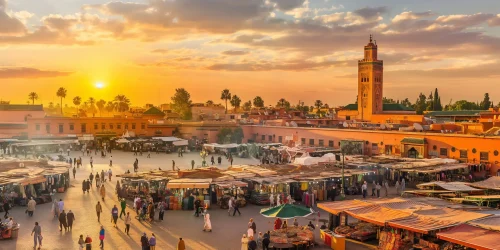Vientiane, the capital city of Laos, is a fascinating blend of traditional Lao culture and French colonial influences. Nestled along the Mekong River, this charming city is often overlooked by travelers, yet it holds a wealth of history, vibrant street life, and serene Buddhist temples that make it a worthy destination.
Must-Visit Landmarks
Pha That Luang
Pha That Luang is the most important national monument in Laos and a symbol of Lao sovereignty and Buddhism. This large, gold-covered Buddhist stupa is believed to have been originally built in the 3rd century, although it has been rebuilt several times. It’s a stunning piece of architecture and offers a serene atmosphere for visitors.
Patuxai (Victory Gate)
Often compared to the Arc de Triomphe in Paris, Patuxai is a war monument in the heart of Vientiane. Built between 1957 and 1968, it honors those who fought for independence from France. Visitors can climb to the top for panoramic views of the city.
Wat Si Saket
Wat Si Saket is the oldest temple in Vientiane and is famous for its cloister wall housing thousands of tiny Buddha images and rows with hundreds of seated Buddhas. The temple’s architecture and calm atmosphere make it a lovely spot for reflection and photography.
COPE Visitor Centre
This informative and moving museum highlights the issues faced by Lao people due to unexploded ordnance (UXO) from the Vietnam War. It’s an educational experience that raises awareness about the ongoing challenges in Laos and the efforts to assist those affected.
Cultural Insights
Morning Market (Talat Sao)
Talat Sao is Vientiane’s bustling morning market, where you can find everything from fresh produce to traditional Lao textiles and crafts. It’s an excellent place to immerse yourself in local culture and practice your bargaining skills.
Buddhist Alms Giving Ceremony
If you’re an early riser, witnessing the daily alms giving ceremony is a must. Monks from local monasteries walk through the streets to collect alms from the devout. This tradition is a beautiful and serene start to the day.
Culinary Delights
Laap
Laap, sometimes spelled ‘larb,’ is a traditional Lao meat salad that’s considered the national dish. It’s made with minced meat, fish, or mushroom, and mixed with fish sauce, lime juice, toasted rice, and herbs. It’s often enjoyed with sticky rice.
Tam Mak Hoong (Papaya Salad)
This spicy green papaya salad is a staple in Lao cuisine. It’s made with shredded unripe papaya, tomatoes, lime, garlic, fish sauce, and a generous amount of chili peppers. It’s both refreshing and fiery, perfect for those who love spicy food.
French Influence
Due to its colonial past, Vientiane also boasts a number of French bakeries and cafés. Enjoy a morning croissant or baguette with Lao coffee at one of the many quaint establishments dotted around the city.
Travel Tips
- Getting Around: Vientiane is a relatively small city, and many of its attractions are within walking distance. For longer journeys, tuk-tuks and rental bicycles are popular options.
- Currency: The local currency is the Lao Kip (LAK). While some places accept US dollars and Thai Baht, it’s best to carry Kip for local transactions.
- Best Time to Visit: The ideal time to visit Vientiane is during the cool dry season from November to February. This period offers comfortable temperatures and lower humidity.
Vientiane, with its mix of historical landmarks, vibrant markets, and delectable cuisine, provides a rich and immersive experience for travelers. Whether you’re exploring ancient temples, savoring local dishes, or simply soaking in the laid-back vibe of the city, Vientiane promises an unforgettable journey through the heart of Laos.









